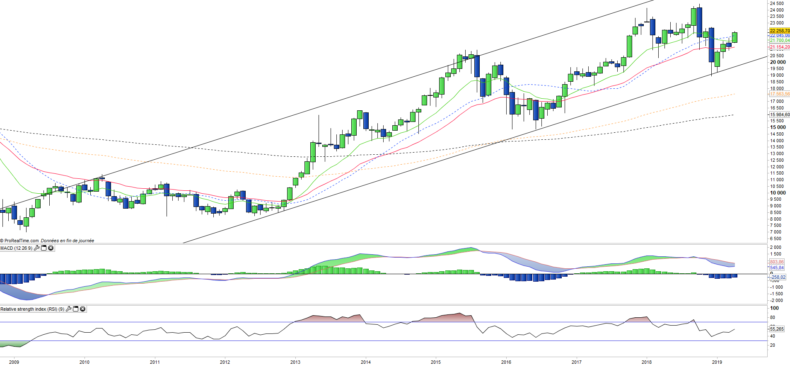Nikkei 225 index (NK225) - 26/04/19
Short Term trend: Positive (75/100)
Long Term trend: Positive (85/100)
(scores computed by our proprietary algorithms - cf methodology)
Index profile
The Nikkei 225 index is very deep and fairly representative of the Japanese economy.
The industry in all its forms (consumer cyclical, heavy industry ...) is strongly represented in the index (overall about 42%) with a health sector at about 10%, while the technology sector is quite important and represents 16% of the index.
In the first 10 capitalizations we will find growth companies like Softbank or Kyocera.
The Japanese economy is the third largest in the world, behind the US and China, with a GDP of about $ 5000 billion, a highly diversified economy based on services and industry / advanced technology and whose model of growth is based on exports of consumer goods (automotive, technological goods) of capital goods and infrastructure, which is somewhat similar to that of Germany.
The Japanese economy is quite dependent on the evolution of its currency with the main world currencies (Dollar, Euro, Renminbi, Sterling), while the most important problem remains that of the deflation which lasts for two decades. This deflation first came from a time adjustment of the price of assets that had entered a bubble (1980s), but it is also due to a structural problem linked to the declining demography not compensated by immigration.
Japan is today the most indebted country in the developed world but the national debt is held by the Japanese and not by foreign funds which limits the risk of financial crisis, but which, on the other hand, forces the economic recovery. The reassuring news from China and the deepening of the economic partnership with India, however, are favorable factors while the current valuations of the Japanese index are still reasonable with a potential for high earnings growth.
After rising 10% in 2017, the Nikkei225 index fell by 5% in 2018 due to fears about global trade. The rebound has been there since the beginning of the year and the index is up + 14% in 2019. The Japanese economy showed signs of weakness at the beginning of the year, but the robustness of both the US and Chinese economies should allow a rebound in exports and investment in the second half.
The evolution of the YEN / USD parity is quite stable but rather downward, which is a positive for the Japanese exporting companies.
Instruments: CSNKY (iShares JPY), JPN (Lyxor in Euro), EWJ (iShares in USD)
Technical Analysis
Monthly data analysis
The monthly chart shows a trend that is again clearly bullish, after a deep correction but much less pronounced than in 2016. Prices have moved back above moving averages that seem ready to return ascending, while the index is moving higher within a major uptrend channel whose bottom line was affected at the end of 2018. The natural target of the index is the top of the channel located at around 25000 pts.
Weekly data analysis
On the weekly chart we can see that the EMAs13 and 26 have just crossed on the rise which is a bullish medium term signal. The MACD is rapidly moving towards the zero line, the crossing of which would be a confirmation of the bullish reversal signal. The other technical indicators (including the RSI) have already turned upwards, which bodes well for the rest of the movement.
Country breakdown
| Japan | 100% |
Sector Breakdown
| Consumer Discretionary | 20% |
| Industrials | 20% |
| Information Technology | 16% |
| Health Care | 10% |
| Consumer Staples | 10% |
| Communication Services | 10% |
| Materials | 7% |
| Others | 5% |
Top Ten Holdings
| Fast Retailing | 10% |
| Softbank Group | 6% |
| Fanuc | 3% |
| Tokyo Electron | 3% |
| KDDI | 2% |
| Daikin Industries | 2% |
| Kyocera | 2% |
| Terumo | 2% |
| Familymart Uny Holdings | 2% |
| Shin Etsu Chemical | 2% |


